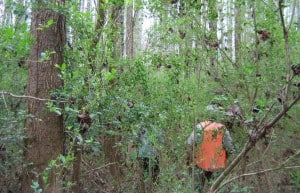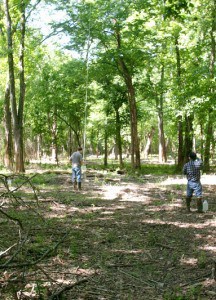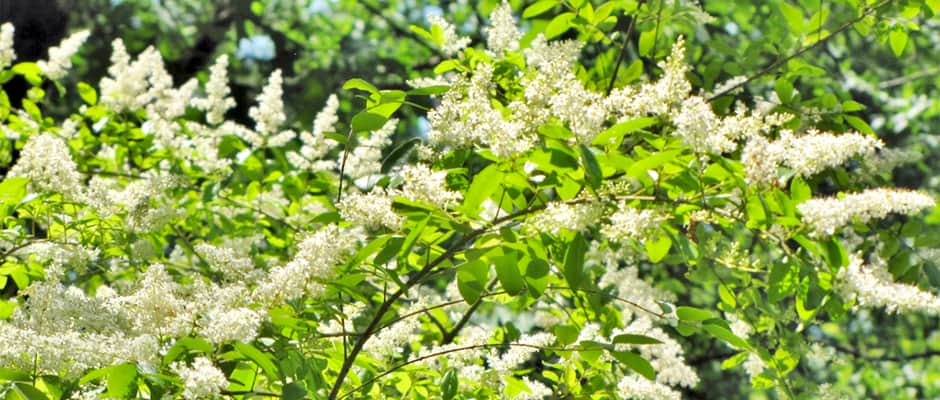Share this article
When privet is removed, native plants and pollinators return
Forests infested with privet invoke a kind of despair in people attuned to the problem of invasive plants. Privet invades a forest quickly, sprawling across the understory and growing into thickets that crowd out native plants and change the very ecology of an area. Even if the woody shrub can be removed effectively, can a forest return to any semblance of its previous condition?
Results from a five-year study published in 2014 by U.S. Forest Service researchers showed that not only can a thorough removal of privet last at least five years without a follow-up, but also that native plant and animal communities steadily return to areas cleared of the invasive shrub.

Researchers in a 40-year-old privet stand within the forest. Photo courtesy of the U.S. Forest Service.
In 2005, Forest Service Southern Research Station (SRS) and State and Private Forestry started an experiment to assess the long-term effects of removing Chinese privet from streamside forest land in northern Georgia. SRS research entomologist Jim Hanula (recently retired) and entomologist Scott Horn, both based in Athens, Georgia, as part of the SRS Insects, Diseases, and Invasive Plants unit, worked with John Taylor (retired, Forest Service, Region 8, State and Private Forestry) to set up plots to test methods of removing privet and to document the return of native plant communities and the response of insect pollinators.
First introduced into the U.S. as an ornamental in 1852, Chinese privet (Ligustrum sinense) escaped cultivation by the 1930s and spread across the Southeast. “It’s common in streamside areas, possibly because they’re similar to its native habitat in China,” said Hanula. “Chinese privet is the primary cause of the decline in the abundance and diversity of native herbaceous plants and tree seedlings in the areas along streams and rivers it infests.”
Researchers tested two methods for removing privet. In one set of plots, they used a mechanical mulching machine to grind up privet to the ground level, leaving the mulch on the plots. In the other set of plots, crews with chainsaws and machetes felled privet by hand. Stumps in both sets of plots were initially treated with herbicide to prevent resprouting, and the areas were treated again with a foliar spray a year later to address new sprouts. By 2007, the plots had less than one percent of their surfaces covered by privet compared to over 60 percent on control plots where privet was left untreated.
Hanula and Horn began investigating how privet removal affected the recovery of plant and animal communities by comparing the treated plots to reference areas that had never been invaded by privet and control plots that were invaded and not treated. They published their initial findings on plant communities two years after control in 2010.
“The results were dramatic,” said Horn. “The hardwood forests we’re working on are some of the most beautiful places in the South when they’re not choked with privet. We saw the return of native plant species in all of the treated plots.”
Results from their studies on pollinators were even more dramatic. “After only two years, there were four to five times more bee species in privet-free areas, 40 or 50 compared to the 10 on control plots infested with privet,” said Hanula. “We caught three times as many butterfly species on the mulched plots and nearly seven times as many individuals.”

Plot where privet was removed and canopy traps installed for research. Photo courtesy of the U.S. Forest Service.
In 2014, five years after treatment, University of Georgia graduate student Jacob Hudson, along with Hanula and Horn, published an article in the journal Biological Conservation documenting the continued long-term benefits of removing privet to both bees and butterflies.
In an additional article published in the journal Forest Ecology and Management, Hudson, Hanula and Horn also reported on the status of plant communities and the growth of canopy trees five years after the complete removal of privet. This is one of the longest studies on the effects on forests of removing invasive plants.
At five years, approximately seven percent of the mulched plots were covered with privet seedlings, higher than the three percent in the hand-felled plots. Both were much lower than the 34 percent cover in the control plots. Native plant species richness also differed among treatments. Mulched plots had the highest number of species, significantly higher than in felled and control plots, but comparable to the uninfested reference plots. Removal of Chinese privet caused no detectable changes in the growth of trees.
“Overall, these results are encouraging, since we expected to have to re-treat the privet more frequently to preserve the integrity of the removal plots,” said Horn. “These results show that control following one removal event lasts at least five years.”
For more information, email Jim Hanula at jhanula@fs.fed.us or Scott Horn at shorn01@fs.fed.us.
Read about privet removal effects on plant communities and canopy trees.
Header Image: ©Buddha Dog








